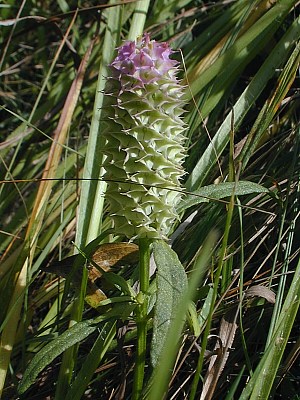Description:
This
annual plant is 4-12" tall and usually unbranched. The central
stem is angular and hairless. The leaves occur in whorls of 4 and are
sessile against the stem. They are up to 1½" long and 1/3" (8 mm.)
across,
linear or linear-oblong in shape, with smooth margins. The central stem
terminates in a dense spike of flowers up to 2-3" long and 1" across.
These flowers are variable in color, ranging from purplish pink or pink
to greenish white. Each flower is about 1/3" (8 mm.) across, consisting
of 2
large sepals (called 'wings'), 3 tiny sepals, and 3 petals that form a
narrow tube with a crest at its apex. The wings are the most
conspicuous part of the flower and determine its color. They are
broadly triangular (or deltoid) in shape, and lie to the right and left
of the tubular petals. These wings persist on the spike long after the
petals have fallen off, and have the appearance of sharp-pointed
bracts. The narrow tubular petals are observable near the apex of the
spike. They are usually some shade of pink, but quickly fade to
brownish yellow, before falling off the spike. The blooming period
occurs from mid-summer to early fall, and lasts about 1-2 months. When
fertilization occurs, each flower is replaced by a 2-seeded capsule.
The seeds are hairy. The root system consists of a taproot. This plant
spreads by reseeding itself.

Cultivation:
The preference is full or partial sun, and moist sandy soil. The pH
should be somewhat acid. This plant can withstand occasional flooding
if it is temporary.
Range & Habitat:
Cross-Leaved Milkwort occurs primarily in NE Illinois (see Distribution
Map). It is an uncommon plant and native to Illinois.
Habitats include moist sand
prairies, shrub prairies, sandy Black Oak savannas, and edges of sandy
marshes. It also occurs along paths in these areas, preferring the
reduced competition from taller plants.
Faunal Associations:
Probably small to medium-sized long-tongued and short-tongued bees
visit the flowers for nectar. Little information is available about
this plant's value as a food source to birds or mammals.
Photographic Location:
Along a path in the Hooper Branch Savanna Nature Preserve in Iroquois
County, Illinois, where Cross-Leaved Milkwort occurred in a moist sand
prairie that was somewhat shrubby and sunny moist areas of Black Oak
Savanna. This area was prone to occasional flooding from heavy rains.
Comments:
The thick spike of flowers of this odd little plant is very conspicuous
and easy to spot. Cross-Leaved Milkwort is relatively easy to identify
because of the bract-like wings that spread horizontally (left and
right) from the center of each flower. In other species of Milkwort,
these wings are held upright and resemble petals. The whorled leaves
are another distinctive feature, as many species of Milkwort have
alternate leaves. Another common name for this plant is 'Drumheads,'
which refers to the shape of the stout spike of flowers. Different
varieties of Cross-Leaved Milkwort have been described, but only Polygala
cruciata aquilonia is known to occur in Illinois.